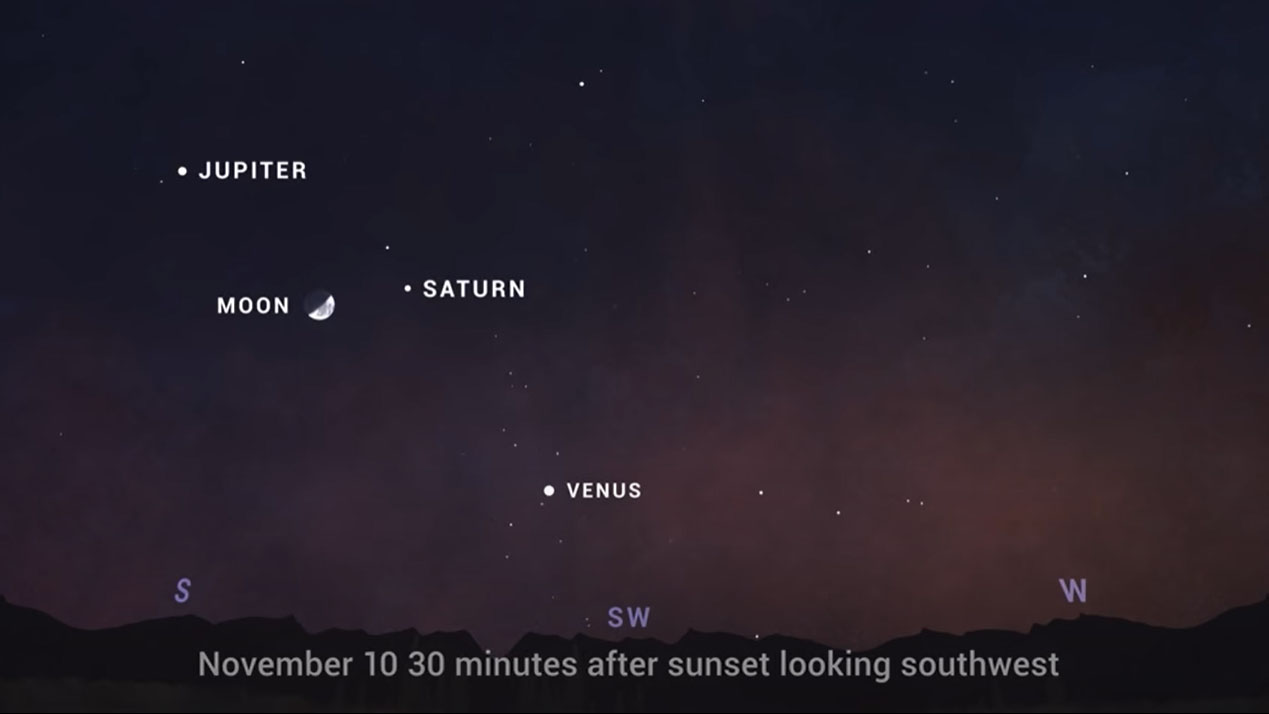You can see the moon near Saturn in the night sky tonight. Here's how.
The crescent moon will swing by Saturn on Wednesday before making a close approach to Jupiter in Thursday's evening sky.

For two nights in a row starting Wednesday (Nov. 10), you can see the moon pass by two bright worlds in Earth's sky.
The moon will be about 4 degrees from Saturn on Wednesday as the two objects reach a conjunction, or an event in which two celestial worlds appear close to each other in the sky. You can spot the moon and Saturn together shortly after sunset. From New York City, according to the skywatching site In-The-Sky.org, you can spot the two worlds starting at 5:01 p.m. EST or local time, and they will both be visible until 9:17 p.m.
Then comes another close encounter on Thursday (Nov. 11), when the moon and bright Jupiter will also come within four degrees of each other. You can spot the pair starting around 5:02 p.m. in New York City, where they will be visible until roughly 10:34 p.m. local time, according to In-The-Sky.org.
Related: How to photograph the moon using a camera
Note: If you're looking for binoculars or a telescope to see planets in the night sky, check our our guide for the best binoculars deals and the best telescope deals now. If you need imaging gear, consider our best cameras for astrophotography and best lenses for astrophotography to make sure you're ready for the next skywatching event.
If you take a photograph of the moon, Jupiter or Saturn let us know! You can send images and comments in to spacephotos@space.com.
The moon, planets and many other worlds nearby us share a path in the sky called the ecliptic, which represents the plane of the solar system. This happy coincidence leads to opportunities throughout the year where the moon and planets come close to each other. Sometimes, the worlds line up; for example, the moon will go into a partial lunar eclipse on Nov. 19 when it passes through Earth's shadow.
Saturn and Jupiter are very bright right now, so you can see the show with your naked eye. Jupiter is at magnitude -2.4 and Saturn at magnitude 0.4. For comparison, the brightest star in the sky is Sirius (magnitude -1) and naked eye visibility is generally accepted to be about magnitude 6 in areas with little or no light pollution.
Breaking space news, the latest updates on rocket launches, skywatching events and more!
To get the most out of your observing session, let your eyes adjust to the sky for at least 20 minutes. Stay as far away from bright lights as you can. If you'd like to consult a sky chart using your phone or a flashlight, make sure to use a red filter to preserve your night vision. If you live in a cold region, make sure to bundle up.
More ambitious astronomers can bring out binoculars or a telescope to see more during the conjunctions. The binoculars should allow you to see the craters of the moon, and a small telescope should show you the rings of Saturn and the four Galilean moons of Jupiter: Europa, Enceladus, Ganymede and Io.
If you're looking for binoculars or a telescope to see planets in the night sky, check our our guide for the best binoculars deals of 2021 and the best telescope deals now. If you need equipment, consider our best cameras for astrophotography and best lenses for astrophotography to make sure you're ready for the next planet sight.
Follow Elizabeth Howell on Twitter @howellspace. Follow us on Twitter @Spacedotcom and on Facebook.

Elizabeth Howell (she/her), Ph.D., was a staff writer in the spaceflight channel between 2022 and 2024 specializing in Canadian space news. She was contributing writer for Space.com for 10 years from 2012 to 2024. Elizabeth's reporting includes multiple exclusives with the White House, leading world coverage about a lost-and-found space tomato on the International Space Station, witnessing five human spaceflight launches on two continents, flying parabolic, working inside a spacesuit, and participating in a simulated Mars mission. Her latest book, "Why Am I Taller?" (ECW Press, 2022) is co-written with astronaut Dave Williams.

